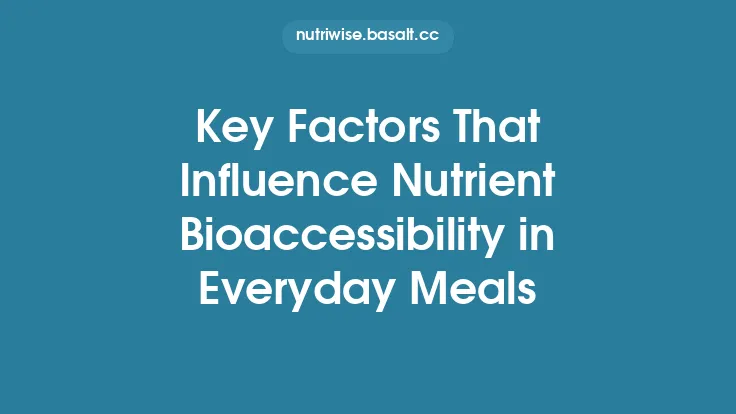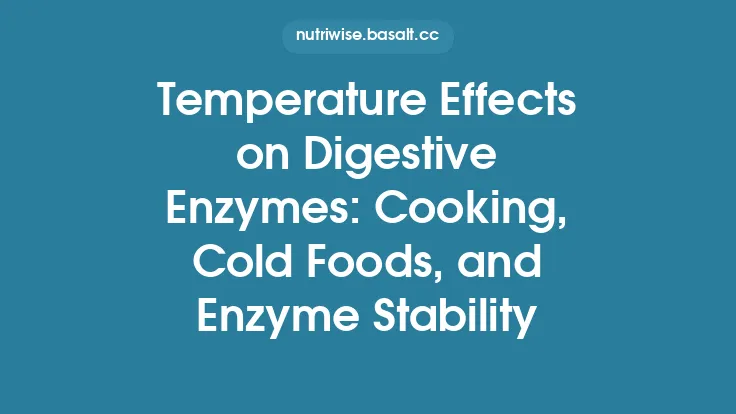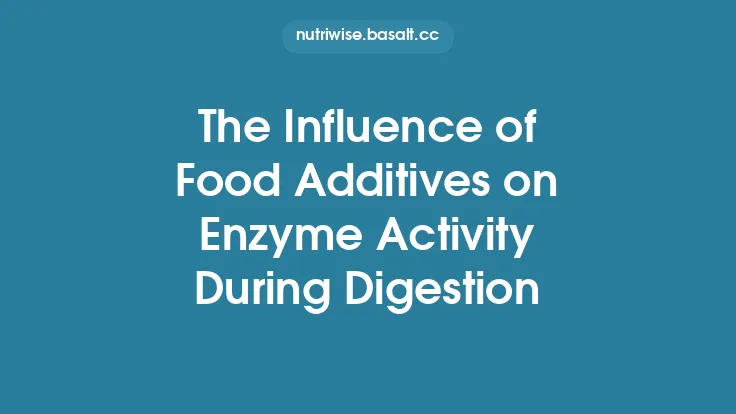Digestive efficiency hinges not only on the presence of the right enzymes but also on how those enzymes are turned on, modulated, or turned off at the right moments. While the sheer quantity of amylase, proteases, or lipases is often highlighted, the real story of nutrient breakdown lies in the intricate network of activation and inhibition mechanisms that govern enzyme performance throughout the gastrointestinal tract. Understanding these regulatory layers helps explain why identical meals can be processed differently by the same individual on different days, and why certain dietary patterns consistently support smoother digestion. Below, we explore the principal factors that activate or inhibit digestive enzymes, emphasizing the biochemical and physiological nuances that shape overall digestive efficiency.
Zymogen Activation: The Built‑In Switches of Digestive Enzymes
Many digestive enzymes are synthesized as inactive precursors called zymogens. This strategy protects the tissues that produce them from premature autolysis. In the pancreas, for example, trypsinogen, chymotrypsinogen, and proelastase are secreted into the duodenum where they encounter specific activators. The conversion of trypsinogen to trypsin is catalyzed by the enzyme enteropeptidase (also known as enterokinase) anchored to the brush‑border membrane of the duodenal epithelium. Once a single molecule of trypsin is generated, it autocatalytically activates additional trypsinogen molecules and also cleaves pro‑chymotrypsin and pro‑elastase, creating a cascade of activation events.
Key points about zymogen activation:
- Spatial control – Activation occurs only after the zymogen reaches the lumen, preventing intracellular damage.
- Temporal sequencing – Early activation of trypsin ensures a rapid amplification loop, while other enzymes follow in a coordinated order.
- Regulatory safeguards – Pancreatic secretory trypsin inhibitor (PSTI) binds any prematurely activated trypsin within the pancreas, curbing runaway proteolysis.
Disruption of any step—such as a deficiency in enteropeptidase or an excess of PSTI—can blunt enzyme activation, leading to malabsorption despite normal enzyme synthesis.
Allosteric Modulation: Fine‑Tuning Enzyme Performance
Beyond the binary on/off of zymogen conversion, many digestive enzymes possess allosteric sites where molecules bind to alter catalytic activity without occupying the active site. This modulation can be either stimulatory (positive allosteric regulation) or inhibitory (negative allosteric regulation).
- Positive allosteric effectors – Certain short-chain fatty acids produced by microbial fermentation can bind to allosteric pockets on pancreatic lipase, enhancing its affinity for triglyceride substrates.
- Negative allosteric effectors – Small peptides derived from partially digested proteins may bind to allosteric sites on proteases, reducing their turnover rate and preventing excessive proteolysis that could damage the mucosal surface.
Allosteric regulation provides a rapid, reversible means for the digestive system to adapt enzyme activity to the current nutrient load, without the need for new enzyme synthesis or secretion.
Hormonal and Neural Regulation of Enzyme Secretion
The gastrointestinal tract is a neuro‑endocrine organ, and enzyme secretion is tightly coupled to hormonal and neural cues that reflect the presence, composition, and volume of ingested food.
- Cholecystokinin (CCK) – Released by I‑cells in the duodenum in response to fatty acids and amino acids, CCK stimulates the pancreas to secrete a cocktail of proteases, lipases, and bicarbonate. It also slows gastric emptying, allowing more time for enzyme action in the small intestine.
- Secretin – Triggered primarily by acidic chyme entering the duodenum, secretin prompts the pancreas to release bicarbonate‑rich fluid, creating an optimal environment for enzyme function and indirectly influencing enzyme activation by diluting inhibitory substances.
- Vagal stimulation – Parasympathetic input via the vagus nerve enhances pancreatic enzyme secretion through acetylcholine release, while sympathetic activation generally suppresses it.
These signaling pathways ensure that enzyme output matches the digestive demand, preventing wasteful over‑secretion or insufficient enzymatic capacity.
Dietary Components as Natural Enzyme Inhibitors
Many foods contain compounds that can directly inhibit digestive enzymes, a fact that has been exploited both nutritionally and pharmaceutically.
- Tannins – Polyphenolic molecules abundant in tea, coffee, and certain fruits can bind to proteases, forming reversible complexes that lower proteolytic activity.
- Lectins – Found in legumes and grains, lectins can interact with the active sites of amylases and proteases, reducing their catalytic efficiency.
- Phytates – While primarily known for mineral chelation, phytates can also impede lipase activity by sequestering calcium ions essential for the enzyme’s structural integrity.
These inhibitors are often heat‑labile; cooking can diminish their potency, which explains why raw versus cooked preparations of the same food may differ markedly in digestibility.
The Role of Gut Microbiota in Modulating Enzyme Activity
The dense microbial community residing in the colon and, to a lesser extent, the distal small intestine, exerts a profound influence on digestive enzyme dynamics.
- Microbial proteases and carbohydrases – Certain bacterial strains secrete their own enzymes that complement host digestion, especially for complex polysaccharides that human enzymes cannot fully degrade.
- Metabolite‑mediated inhibition – Short‑chain fatty acids (acetate, propionate, butyrate) and other microbial metabolites can act as allosteric modulators of host enzymes, as noted earlier.
- Competitive substrate utilization – When microbes rapidly ferment available carbohydrates, they can reduce the substrate pool for pancreatic amylase, indirectly lowering its apparent activity.
Alterations in microbiota composition—whether through antibiotics, diet, or disease—can therefore shift the balance between activation and inhibition of digestive enzymes.
Genetic Variability and Its Impact on Enzyme Function
Polymorphisms in genes encoding digestive enzymes or their regulators can lead to inter‑individual differences in activation efficiency and susceptibility to inhibition.
- PRSS1 and PRSS2 variants – Mutations in the trypsinogen genes can produce enzymes that are either hyper‑active or resistant to natural inhibitors, predisposing carriers to pancreatitis or malabsorption.
- CEL gene polymorphisms – Variants affecting the pancreatic lipase‑related protein can alter its interaction with lipid substrates and with inhibitory dietary components.
- Regulatory region SNPs – Single‑nucleotide polymorphisms in promoter regions of CCK or secretin genes can modulate hormone levels, indirectly influencing enzyme secretion.
Understanding these genetic factors is essential for personalized nutrition strategies aimed at optimizing digestive efficiency.
Pathophysiological Conditions that Alter Enzyme Activation
Several disease states interfere with the normal activation cascade or increase the presence of inhibitory factors.
- Chronic pancreatitis – Fibrotic replacement of acinar tissue reduces the pool of zymogen granules, while inflammatory mediators increase the expression of endogenous protease inhibitors, dampening overall enzyme activation.
- Cystic fibrosis – Thickened secretions obstruct pancreatic ducts, preventing zymogen release into the duodenum and allowing premature activation within the gland, which can damage pancreatic tissue.
- Celiac disease – Villous atrophy diminishes the surface area for enteropeptidase expression, slowing the conversion of trypsinogen to trypsin and impairing downstream protease activation.
These conditions illustrate how structural or functional disruptions can tip the balance toward inhibition, leading to nutrient malabsorption.
Interactions Between Enzyme Inhibitors and Therapeutic Drugs
Certain medications inadvertently affect digestive enzyme activity, either by direct inhibition or by altering regulatory pathways.
- Proton pump inhibitors (PPIs) – While primarily affecting gastric acidity, PPIs can reduce the secretion of enteropeptidase‑rich brush‑border membranes, indirectly slowing trypsin activation.
- Non‑steroidal anti‑inflammatory drugs (NSAIDs) – By compromising mucosal integrity, NSAIDs can increase the leakage of pancreatic enzymes into the interstitium, prompting a compensatory rise in endogenous inhibitors.
- Antibiotics – Broad‑spectrum agents can disrupt gut microbiota, diminishing microbial enzyme contributions and altering metabolite‑mediated allosteric regulation.
Clinicians should be aware of these secondary effects when prescribing long‑term therapies, especially for patients with existing digestive concerns.
Food Matrix and Physical Structure: How Texture Influences Enzyme Access
The physical form of ingested food dictates how readily enzymes can interact with substrates.
- Particle size – Mechanical breakdown during chewing reduces particle size, increasing surface area and exposing more substrate to enzymatic attack. Larger particles may remain partially undigested, effectively “inhibiting” enzyme action by limiting access.
- Viscosity – High‑viscosity foods (e.g., those rich in soluble fiber) can create a diffusion barrier that slows enzyme–substrate collisions, reducing the apparent rate of digestion.
- Encapsulation – Natural food structures such as cell walls in whole grains or plant tissues can sequester nutrients, requiring additional mechanical or enzymatic steps for release. Processing methods that disrupt these matrices (e.g., milling, cooking) generally enhance enzyme activation by making substrates more available.
Thus, the food matrix itself acts as a modifiable factor that can either facilitate or impede enzyme activity.
Strategies to Optimize Enzyme Activation and Minimize Inhibition in Everyday Diets
Applying the knowledge of activation and inhibition mechanisms can help individuals tailor their eating habits for better nutrient absorption.
- Incorporate moderate cooking – Heat can denature natural enzyme inhibitors (tannins, lectins) while preserving the integrity of macronutrients.
- Balance meal composition – Pairing high‑protein foods with modest amounts of fat and fiber avoids overwhelming any single inhibitory pathway (e.g., excessive tannins from tea with a protein‑rich meal).
- Chew thoroughly – Adequate mastication reduces particle size, enhancing the exposure of substrates to salivary and gastric enzymes before they reach the small intestine.
- Support a healthy microbiota – Consuming prebiotic fibers and fermented foods promotes microbial populations that produce complementary enzymes and beneficial metabolites.
- Mind medication timing – When possible, separate the intake of drugs known to affect digestive regulation from main meals to reduce interference with enzyme activation.
- Consider genetic testing – For individuals with recurrent digestive issues, screening for relevant enzyme gene variants can guide personalized dietary adjustments.
By consciously addressing the factors that govern enzyme activation and inhibition, one can improve digestive efficiency, reduce gastrointestinal discomfort, and enhance overall nutrient utilization.





